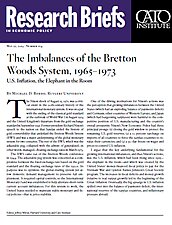The BWS came out of the Bretton Woods conference in 1944. The adjustable peg system was conceived as a compromise between the fixed exchange rate based on the gold standard and the floating exchange rates of the 1920s. Its purpose was to optimize the global-trading system yet allow domestic demand management to preserve full employment. It required capital controls, so the International Monetary Fund was established to help alleviate short-term current account imbalances. For this system to work, the United States needed to maintain stable monetary and fiscal policies—that is, price stability.
One of the driving motivations for Nixon’s actions was the perception that growing imbalances between the United States (which had an exploding balance of payments deficit) and Germany, other countries of Western Europe, and Japan (which had burgeoning surpluses) were harmful to the competitive position of U.S. manufacturing and the country’s overall prosperity. Nixon’s New Economic Policy had three principal prongs: (1) closing the gold window to protect the remaining U.S. gold reserves; (2) a 10 percent surcharge on imports of all countries to force the surplus countries to revalue their currencies; and (3) a 90-day freeze on wages and prices to control U.S. inflation.
I argue that the key underlying fundamental for the growing international imbalances, and thus Nixon’s actions, was the U.S. inflation, which had been rising since 1965— the elephant in the room—and which was created by the United States’ money-financed fiscal policy to pay for the Vietnam War and Lyndon Baines Johnson’s Great Society program. The increases in fiscal deficits and money growth (relative to real output growth) led to the beginning of the Great Inflation. Eventually, the big upsurge in U.S. inflation spilled over into the balance of payments deficit, the international reserves of the surplus countries, and inflationary pressure abroad.
What was kept in the background on August 15, 1971, was that U.S. inflation, driven by U.S. macro policies, was the main problem facing the BWS, and that for political and doctrinal reasons it was not directly addressed. Nixon blamed the rest of the world instead of correcting U.S. monetary and fiscal policies. In addition, at the urging of former Federal Reserve chairman Arthur F. Burns, Nixon adopted wage and price controls to mask the inflation, hence punting the problem into the future. This decision in turn reflected both Burns’s and the Nixon administration’s unwillingness to recognize the elephant in the room and use monetary policy to reduce inflation directly. This reflected Nixon’s fear of a recession weakening his re-election chances in the forthcoming 1972 presidential election and Burns’s surrendering the Federal Reserve’s independence to political pressure.
I revisit the story of the collapse of the BWS and the origins of the Great Inflation. Based on narratives as well as conversations with the Honorable George P. Shultz, a crucial player in the events of the period 1969–1973, I argue that the pursuit of tighter monetary and fiscal policies could have prevented most of the turmoil in the waning years of Bretton Woods. Moreover, I point out some similarities between the imbalances of the 1960s and 1970s and those of today, especially regarding fiscal policies and the use of tariff protection as a strategic tool. I also point out some differences, such as relatively stable monetary policy and floating exchange rates.
The major policy issue in the United States and the rest of the world in the 1960s and 1970s was inflation. That is not the case today, although it could be if the Federal Reserve is too slow to tighten monetary policy. Rather, the key policy issues today are fiscal debt and expansion. In the 1960s and 1970s, the issue was a run-up in fiscal deficits that began in 1965 and continued through the 1970s. In recent years, major fiscal expansion to stem both the Great Recession and a significant run-up in the debt-to-GDP ratio has not been rolled back. The recent tax cuts have increased the fiscal imbalance and are raising the debt ratio to historically high levels. As the Federal Reserve tightens to normalize monetary policy, if inflation were to pick up beyond the 2 percent level, debt service costs will rise, which will add to the fiscal imbalances. Aggravating the problem are entitlements that cannot be cut. This means that fiscal consolidation without an increase in fiscal space could move the United States in the direction of a debt crisis. This is a different imbalance than in the 1960s and 1970s but is still a serious one. Indeed, a sovereign debt crisis would threaten the credibility of the dollar as an international currency.
A second source of resonance from the earlier crisis is the use of tariff protection. At Camp David, the 10 percent temporary import surcharge was imposed as a strategic bargaining tool to force the surplus countries to adjust. It was successful in bringing about the Smithsonian agreement—a compromise to revalue the dollar, Yen, and European currencies and to expand exchange rate bands—but in the end, the only solution to the problem of the imbalances of the BWS was floating exchange rates. Today, the use of tariffs as a threat to force trading partners (especially China) to change their industrial policies risks the same kind of reaction that ultimately made the Camp David strategy fail; the Smithsonian Agreement lasted only several months, and the underlying fiscal and monetary imbalances became even worse. It also raises the specter of a trade war such as the one that occurred in the 1930s and greatly exacerbated the Great Depression.
NOTE:
This research brief is based on Michael D. Bordo, “The Imbalances of the Bretton Woods System, 1965–1973: U.S. Inflation, the Elephant in the Room,” NBER Working Paper no. 25409, December 2018, https://www.nber.org/papers/w25409.

